
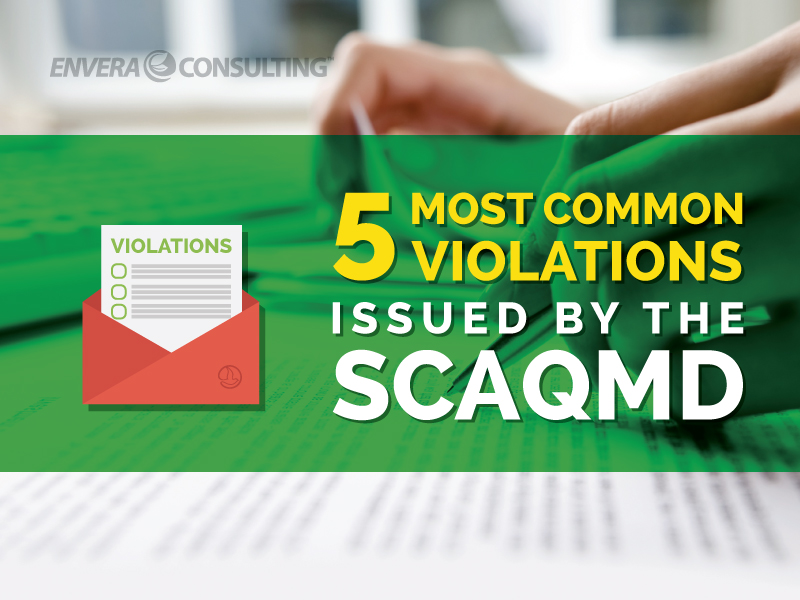
The following text is an abridged and edited transcript of the video that follows at the end of this post.
Receiving a notice of violation (NOV) is never fun, to put it mildly. But fear not! There are ways to minimize your chances of receiving one. Just performing simple, regularly scheduled tasks can help ensure you stay in compliance.
Before we review the most common violations and how to minimize them, let’s first review some of the data.
Data on SCAQMD Violations
Between 2012 and mid-2015, a total of 2,722 violations were determined. The total settlement payout amounted to $25,265,77.86. If we divide the total settlement by the number of violations, we see that the average violation costs $928.61. That’s just under $1,000 per violation — which is far lower than most individual settlements.
When you look closely at the data, you’ll start to notice some trends. At Envera, we use this data — particularly the trend part — to recognize patterns that can help our clients stay in compliance with all of the SCAQMD’s rules and regulations.
Of the 2,722 violations the agency issued between 2012 and mid-2015, approximately 60 percent are due to just five different rule-violations.

If we go deeper, we find that a little over 50 percent of SCAQMD violations are for being in violation of three rules. One level deeper and we see that about 25 percent of the rule-violations are due to being in violation of one rule: Rule 203, which is related to an equipment’s permit to operate. (Can you tell I like to crunch numbers?)
So, how can you use the data to prevent violations within your own facility? Start by looking at the following five rules:
1. Rule 203
Although theoretically a simple rule with only two provisions, Rule 203 accounts for roughly 25 percent of the violations issued by the SCAQMD. In a nutshell, the rule requires facilities to have a permit to operate their equipment. These operating permits come with specific conditions for compliance printed right on the front. The conditions come in a number of shapes and flavors, but the two most common ones — which we’ve seen on nearly every single permit — are:
- You must operate your equipment consistent, or in a manner that is consistent, with the information that you provided in your application.
- You must keep your equipment in good operating condition.
Although these two conditions might seem pretty basic, they’re so commonly overlooked that they are arguably the easiest way to get a violation. Let’s take a look at these examples taken straight from the SCAQMD database:
Operating Contrary to Permit Conditions
In this example, the facility was operating its equipment contrary to condition C8.1 on their permit:

Equipment Not in Good Operating Condition
In this example, a facility was operating a tank with a hole:
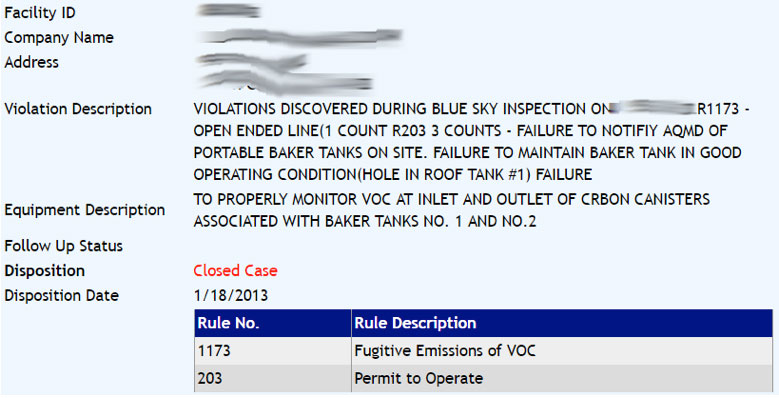
Since a tank is meant to store content, having a hole in the tank would mean it is not in good operating condition. Not only would the content be spilling out, but the tank might also be emitting fugitive emissions.
Solution: Although this may seem obvious, simply adhering to your permit conditions and understanding the information submitted in your original permit application can greatly minimize the chances you’ll be in violation of Rule 203.
If you’re just looking at your permit conditions now and have spotted a problem, you need to resolve it as soon as possible. (See point 3 in our post “3 Best Practices for Permit Conditions.”) Don’t forget to talk to the equipment operators to really understand how things are done in the field. That way, you can determine whether or not operations are consistent with the permit condition or the information submitted in the permit application.
2. Rule 461
This rule applies to facilities that transfer or dispense gasoline, which normally means your average retail gas stations. The rule consists of numerous requirements, including vapor recovery requirements, operation and maintenance plan requirements, testing requirements, and recordkeeping requirements.
Operating Equipment With a Major Defect
Going back to the SCAQMD’s violation database, we can see that a Rule 461 violation is often issued for tears on a hose — i.e., not operating the equipment without any major defects.

Solution: Be sure that you maintain your equipment in good operating condition and without any major defects. Of course, you also want to minimize your facility’s emissions to the best of your ability.
3. Rule 3002
Rule 3002 applies to Title V facilities, which tend to be the largest emitters and are regulated under Title V of the Clean Air Act. So technically speaking, any violation of Rule 3002 can be viewed as a violation of the Clean Air Act — a big no-no. In addition to needing a Title V permit, you must also comply with all the regulations that pertain to your facility or that piece of equipment and with any and all permit conditions.
If a facility is part of the Title V program, all of its active permits are reconciled onto one document, which consolidates all equipment, compliance conditions, recordkeeping requirements, maintenance schedules, reporting requirements, etc.. If you obtain a new piece of equipment and do not apply for a permit to operate, you are in direct violation of Title V.
Not Meeting the Requirements of Title V
In the following example, the facility did not obtain a permit to operate a scrubber, which means the Title V permit was never amended to add this equipment (and its respective compliance conditions):

Solution: In order to minimize your risk for violations under Title V and Rule 3002, it’s best that you always keep the SCAQMD updated on any new process and equipment being added to your facility. In addition, if your process changes, you need to update the agency so they can amend your Title V permit.
4. RECLAIM Program
RECLAIM is the SCAQMD’s cap-and-trade program implemented to reduce the emissions of nitrogen oxides and sulfur oxides — known as NOx and SOx (pronounced “knocks and socks”). Some of the requirements of the RECLAIM program include reporting emissions accurately and holding an amount of RECLAIM trading credits that is equal to or greater than the emissions that you report.
Just like most SCAQMD rules, RECLAIM requires recordkeeping and timely reporting of emissions. One of the most common violations for Rule 2004 (the rule that details all the RECLAIM requirements) is simply inaccurate reporting of emissions.
Inaccurate Reporting of Emissions
In this example, the facility incorrectly reported their emissions for the first two quarters of 2011:
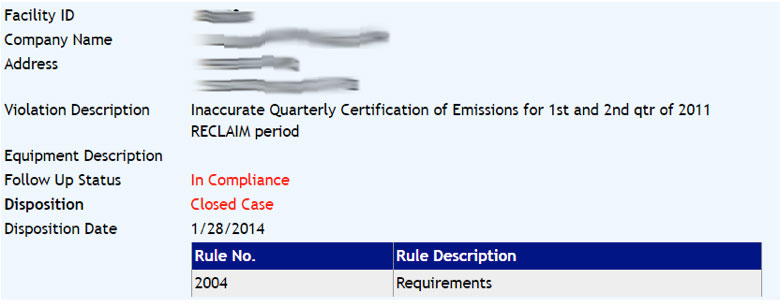
Although we don’t know the extent to which they were misreported, any misreported emissions (yes, even less than 1 percent) can result in a Rule 2004 violation. Simply complying with the basics of Rule 2004 can keep you out of hot water. Of course, you’ll also need to monitor your credit holdings and emissions throughout the year to ensure you have enough credits to cover your emissions.
We’ve seen the same data set interpreted multiple different ways, depending on who’s analyzing the data. This can be problematic because an inspector can get a very different number from the data than what you reported. This doesn’t automatically imply your interpretation of the data is inaccurate, but it can be viewed as grounds for a violation as the inspector’s interpretation takes precedence. If your analysis of the data and that of the inspector’s differ, you can be issued an NOV for inaccurate reporting.
Solution: Aim for reproducibility. By that, I mean you should keep good records so that someone knowledgeable about RECLAIM and your facility can easily reproduce any emission reports submitted to the agency. Clearly document all data, including assumptions, emission factors, sources of emission factors, reports, etc. Keep clean records and document your assumptions. This will help increase the reproducibility of your analysis.
5. Rule 1470
Rule 1470 applies to stationary diesel-fueled engines, such as those that typically power fire pumps, emergency generators, and so forth. The key requirements of Rule 1470 include maintaining records, meeting emission limits, not operating longer than the allowed limits, and, if the equipment is operating near a school, complying with one of the available compliance options.
Two common violations we’ve seen are not meeting emission limits due to operating near a school and not keeping a record of the hours the equipment has been operated.
Not Meeting Emission Limits When Operating Near a School
In the following example, the facility was operating their internal combustion engine within 100 meters of a school and did not meet the respective Rule 1470 PM (particulate matter) emission limit:
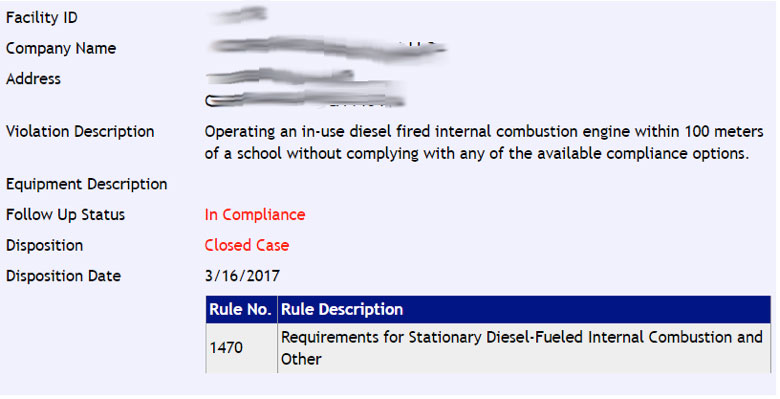
If a non-emergency engine is within 100 meters of a school, it cannot operate between 7:30 AM and 4:30 PM on days school is in session, so be sure to keep these time restrictions in mind when operating such equipment.
Not Keeping Record of Time Equipment Has Been Operated
In the following example, the facility did not keep any records of how long the diesel engine was in operation:
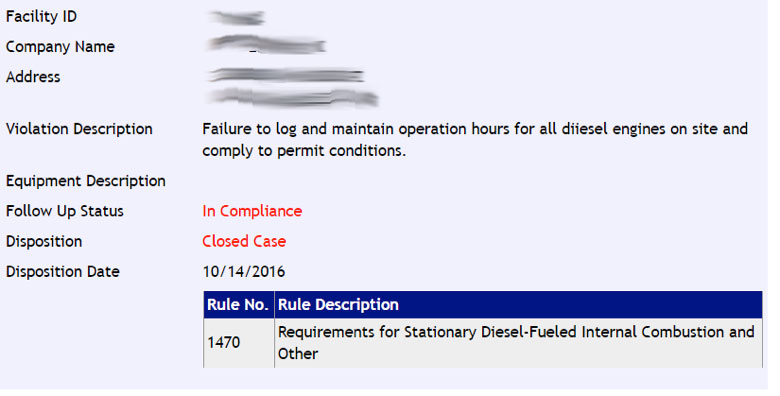
In addition to the time constraints mentioned above, Rule 1470 requires operators keep a record of the times and hours their engine is in operation.
Solution: Not to sound like a broken record, but practicing good recordkeeping is tantamount to staying in compliance. Unique to Rule 1470 are the requirements that your engine operate below the stated hourly limit to the rule and that your engine be a certain distance from a school, so be sure you’re aware of whether or not your equipment is in compliance.
The SCAQMD has scads of rules — and because they can change quickly and seemingly without warning, staying on top of them can be a chore in itself. But, as the saying goes, ignorance of the law is no excuse, and if a rule changes without your knowledge, you could be operating in compliance one day and in violation the next.
The best way to stay on top of rule changes is to take part in the rule-making process, which is public. Short of that, sign up for our newsletter and we’ll keep you updated on the most important rule changes we hear about.